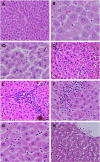In vivo investigation on the chronic hepatotoxicity induced by intraperitoneal administration of 10-nm silicon dioxide nanoparticles
- PMID: 29765215
- PMCID: PMC5944457
- DOI: 10.2147/IJN.S162847
In vivo investigation on the chronic hepatotoxicity induced by intraperitoneal administration of 10-nm silicon dioxide nanoparticles
Abstract
Background: Silicon dioxide (silica) nanoparticles (SDNPs) are widely used in nanotechnology and medicine, but these nanomaterials may carry a high risk for human health while little is known about their toxicity.
Methods: We investigated the alterations in morphometry, biochemistry, hematology, histology of liver tissue and gene expression of drug-metabolizing enzymes induced by 10-nm SDNPs. Healthy male Wistar albino rats were exposed to 20, 35 and 50 repeated injections of SDNPs (2 mg/kg body weight). Whole blood, serum and plasma samples were used for hematological and biochemical analyses, whereas liver biopsies were processed for histopathological and gene expression alterations.
Results: In comparison with control rats, exposure to SDNPs lowered the body weight gain and liver index and increased the counts of white blood cells and platelets, but lowered the platelet larger cell ratio and plateletcrit. Levels of alkaline phosphatase, lactate dehydrogenase, low-density lipids, procalcitonin, aspartate aminotransferase and alanine aminotransferase, as well as potassium, phosphorus and iron concentrations, were increased. Histopathology revealed that SDNPs could induce hydropic degeneration, sinusoidal dilatation, hyperplasia of Kupffer cells, karyopyknosis and infiltration of inflammatory cells in the liver. SDNPs reduced the expression of 12 genes of drug-metabolizing enzymes significantly (p<0.05).
Conclusion: These results suggest that SDNPs could cause alterations in morphometry, biochemistry, hematology, liver tissues and the expression of drug-metabolizing enzyme genes.
Keywords: biochemical alterations; gene expression; hematological alterations; histological alterations; morphometric alterations; toxicity.
Conflict of interest statement
Disclosure The authors report no conflicts of interest in this work.
Figures





Similar articles
-
Lipopolysaccharide augments aflatoxin B(1)-induced liver injury through neutrophil-dependent and -independent mechanisms.Toxicol Sci. 2000 Nov;58(1):208-15. doi: 10.1093/toxsci/58.1.208. Toxicol Sci. 2000. PMID: 11053557
-
Ameliorative effect of Allolobophora caliginosa extract on hepatotoxicity induced by silicon dioxide nanoparticles.Toxicol Ind Health. 2016 Aug;32(8):1358-1372. doi: 10.1177/0748233714561075. Epub 2014 Dec 29. Toxicol Ind Health. 2016. PMID: 25548372
-
Zinc oxide nanoparticles hepatotoxicity: Histological and histochemical study.Environ Toxicol Pharmacol. 2017 Apr;51:124-130. doi: 10.1016/j.etap.2017.02.015. Epub 2017 Feb 16. Environ Toxicol Pharmacol. 2017. PMID: 28236584
-
Kupffer cell-mediated hepatic injury induced by silica nanoparticles in vitro and in vivo.Int J Nanomedicine. 2013;8:1129-40. doi: 10.2147/IJN.S42242. Epub 2013 Mar 15. Int J Nanomedicine. 2013. PMID: 23515466 Free PMC article.
-
Toxicological correlation between changes in blood biochemical parameters and liver histopathological findings.J Toxicol Sci. 1997 Aug;22(3):161-83. doi: 10.2131/jts.22.3_161. J Toxicol Sci. 1997. PMID: 9279820 Review.
Cited by
-
Silicon dioxide nanoparticles induced neurobehavioral impairments by disrupting microbiota-gut-brain axis.J Nanobiotechnology. 2021 Jun 10;19(1):174. doi: 10.1186/s12951-021-00916-2. J Nanobiotechnology. 2021. PMID: 34112173 Free PMC article.
-
Evaluating the hepatotoxic versus the nephrotoxic role of iron oxide nanoparticles: One step forward into the dose-dependent oxidative effects.Heliyon. 2023 Oct 24;9(11):e21202. doi: 10.1016/j.heliyon.2023.e21202. eCollection 2023 Nov. Heliyon. 2023. PMID: 37942152 Free PMC article.
-
Hepatotoxicity induced by nanomaterials: mechanisms and in vitro models.Arch Toxicol. 2021 Jan;95(1):27-52. doi: 10.1007/s00204-020-02940-x. Epub 2020 Nov 6. Arch Toxicol. 2021. PMID: 33155068 Review.
-
Gold Nanoparticles Modified With Polyethyleneimine Disturbed the Activity of Drug-Metabolic Enzymes and Induced Inflammation-Mediated Liver Injury in Mice.Front Pharmacol. 2021 Jul 15;12:706791. doi: 10.3389/fphar.2021.706791. eCollection 2021. Front Pharmacol. 2021. PMID: 34335268 Free PMC article.
-
Last Fifteen Years of Nanotechnology Application with Our Contribute.Nanomaterials (Basel). 2025 Feb 10;15(4):265. doi: 10.3390/nano15040265. Nanomaterials (Basel). 2025. PMID: 39997828 Free PMC article. Review.
References
-
- Tallury P, Payton K, Santra S. Silica-based multimodal/multifunctional nanoparticles for bioimaging and biosensing applications. Nanomedicine (Lond) 2008;3(4):579–592. - PubMed
-
- Maurer-Jones M, Lin Y, Haynes C. Functional assessment of metal oxide nanoparticle toxicity in immune cells. ACS Nano. 2010;4(6):3363–3373. - PubMed
-
- He Q, Gao Y, Zhang L, et al. A pH-responsive mesoporous silica nanoparticles-based multi-drug delivery system for overcoming multi-drug resistance. Biomaterials. 2011;32(30):7711–7720. - PubMed
-
- He Q, Shi J. MSN anti-cancer nanomedicines: chemotherapy enhancement, overcoming of drug resistance, and metastasis inhibition. Adv Mater. 2014;26(3):391–411. - PubMed
MeSH terms
Substances
LinkOut - more resources
Full Text Sources
Other Literature Sources
Medical

